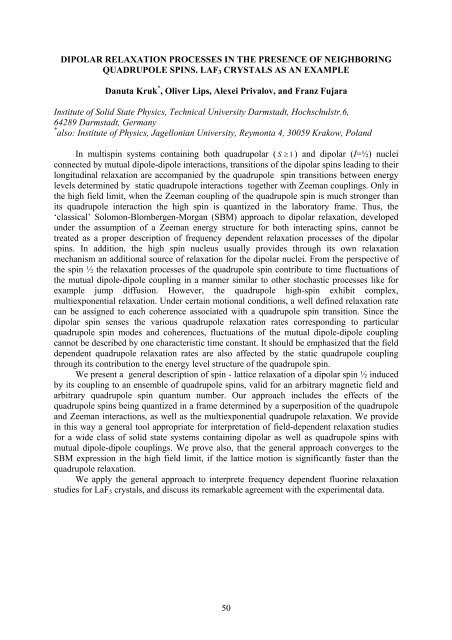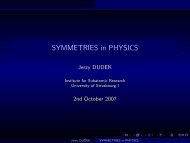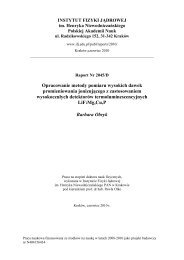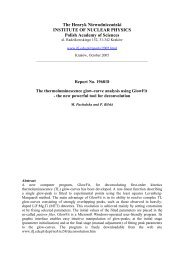Report No 1951/AP - Instytut Fizyki JÄ drowej PAN
Report No 1951/AP - Instytut Fizyki JÄ drowej PAN
Report No 1951/AP - Instytut Fizyki JÄ drowej PAN
Create successful ePaper yourself
Turn your PDF publications into a flip-book with our unique Google optimized e-Paper software.
DIPOLAR RELAXATION PROCESSES IN THE PRESENCE OF NEIGHBORING<br />
QUADRUPOLE SPINS. LAF 3 CRYSTALS AS AN EXAMPLE<br />
Danuta Kruk * , Oliver Lips, Alexei Privalov, and Franz Fujara<br />
Institute of Solid State Physics, Technical University Darmstadt, Hochschulstr.6,<br />
64289 Darmstadt, Germany<br />
* also: Institute of Physics, Jagellonian University, Reymonta 4, 30059 Krakow, Poland<br />
In multispin systems containing both quadrupolar ( S ≥ 1 ) and dipolar (I=½) nuclei<br />
connected by mutual dipole-dipole interactions, transitions of the dipolar spins leading to their<br />
longitudinal relaxation are accompanied by the quadrupole spin transitions between energy<br />
levels determined by static quadrupole interactions together with Zeeman couplings. Only in<br />
the high field limit, when the Zeeman coupling of the quadrupole spin is much stronger than<br />
its quadrupole interaction the high spin is quantized in the laboratory frame. Thus, the<br />
‘classical’ Solomon-Blombergen-Morgan (SBM) approach to dipolar relaxation, developed<br />
under the assumption of a Zeeman energy structure for both interacting spins, cannot be<br />
treated as a proper description of frequency dependent relaxation processes of the dipolar<br />
spins. In addition, the high spin nucleus usually provides through its own relaxation<br />
mechanism an additional source of relaxation for the dipolar nuclei. From the perspective of<br />
the spin ½ the relaxation processes of the quadrupole spin contribute to time fluctuations of<br />
the mutual dipole-dipole coupling in a manner similar to other stochastic processes like for<br />
example jump diffusion. However, the quadrupole high-spin exhibit complex,<br />
multiexponential relaxation. Under certain motional conditions, a well defined relaxation rate<br />
can be assigned to each coherence associated with a quadrupole spin transition. Since the<br />
dipolar spin senses the various quadrupole relaxation rates corresponding to particular<br />
quadrupole spin modes and coherences, fluctuations of the mutual dipole-dipole coupling<br />
cannot be described by one characteristic time constant. It should be emphasized that the field<br />
dependent quadrupole relaxation rates are also affected by the static quadrupole coupling<br />
through its contribution to the energy level structure of the quadrupole spin.<br />
We present a general description of spin - lattice relaxation of a dipolar spin ½ induced<br />
by its coupling to an ensemble of quadrupole spins, valid for an arbitrary magnetic field and<br />
arbitrary quadrupole spin quantum number. Our approach includes the effects of the<br />
quadrupole spins being quantized in a frame determined by a superposition of the quadrupole<br />
and Zeeman interactions, as well as the multiexponential quadrupole relaxation. We provide<br />
in this way a general tool appropriate for interpretation of field-dependent relaxation studies<br />
for a wide class of solid state systems containing dipolar as well as quadrupole spins with<br />
mutual dipole-dipole couplings. We prove also, that the general approach converges to the<br />
SBM expression in the high field limit, if the lattice motion is significantly faster than the<br />
quadrupole relaxation.<br />
We apply the general approach to interprete frequency dependent fluorine relaxation<br />
studies for LaF 3 crystals, and discuss its remarkable agreement with the experimental data.<br />
50

















